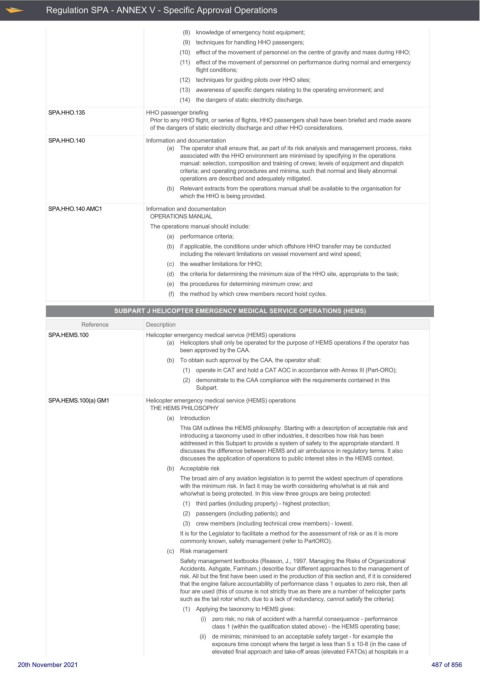Page 487 - UK Air Operations Regulations (Consolidated) 201121
P. 487
~
~ Regulation SPA - ANNEX V - Specific Approval Operations Centrik
(8) knowledge of emergency hoist equipment;
(9) techniques for handling HHO passengers;
(10) effect of the movement of personnel on the centre of gravity and mass during HHO;
(11) effect of the movement of personnel on performance during normal and emergency
flight conditions;
(12) techniques for guiding pilots over HHO sites;
(13) awareness of specific dangers relating to the operating environment; and
(14) the dangers of static electricity discharge.
SPA.HHO.135 HHO passenger briefing
Prior to any HHO flight, or series of flights, HHO passengers shall have been briefed and made aware
of the dangers of static electricity discharge and other HHO considerations.
SPA.HHO.140 Information and documentation
(a) The operator shall ensure that, as part of its risk analysis and management process, risks
associated with the HHO environment are minimised by specifying in the operations
manual: selection, composition and training of crews; levels of equipment and dispatch
criteria; and operating procedures and minima, such that normal and likely abnormal
operations are described and adequately mitigated.
(b) Relevant extracts from the operations manual shall be available to the organisation for
which the HHO is being provided.
SPA.HHO.140 AMC1 Information and documentation
OPERATIONS MANUAL
The operations manual should include:
(a) performance criteria;
(b) if applicable, the conditions under which offshore HHO transfer may be conducted
including the relevant limitations on vessel movement and wind speed;
(c) the weather limitations for HHO;
(d) the criteria for determining the minimum size of the HHO site, appropriate to the task;
(e) the procedures for determining minimum crew; and
(f) the method by which crew members record hoist cycles.
SUBPART J HELICOPTER EMERGENCY MEDICAL SERVICE OPERATIONS (HEMS)
Reference Description
SPA.HEMS.100 Helicopter emergency medical service (HEMS) operations
(a) Helicopters shall only be operated for the purpose of HEMS operations if the operator has
been approved by the CAA.
(b) To obtain such approval by the CAA, the operator shall:
(1) operate in CAT and hold a CAT AOC in accordance with Annex III (Part-ORO);
(2) demonstrate to the CAA compliance with the requirements contained in this
Subpart.
SPA.HEMS.100(a) GM1 Helicopter emergency medical service (HEMS) operations
THE HEMS PHILOSOPHY
(a) Introduction
This GM outlines the HEMS philosophy. Starting with a description of acceptable risk and
introducing a taxonomy used in other industries, it describes how risk has been
addressed in this Subpart to provide a system of safety to the appropriate standard. It
discusses the difference between HEMS and air ambulance in regulatory terms. It also
discusses the application of operations to public interest sites in the HEMS context.
(b) Acceptable risk
The broad aim of any aviation legislation is to permit the widest spectrum of operations
with the minimum risk. In fact it may be worth considering who/what is at risk and
who/what is being protected. In this view three groups are being protected:
(1) third parties (including property) - highest protection;
(2) passengers (including patients); and
(3) crew members (including technical crew members) - lowest.
It is for the Legislator to facilitate a method for the assessment of risk or as it is more
commonly known, safety management (refer to PartORO).
(c) Risk management
Safety management textbooks (Reason, J., 1997. Managing the Risks of Organizational
Accidents. Ashgate, Farnham.) describe four different approaches to the management of
risk. All but the first have been used in the production of this section and, if it is considered
that the engine failure accountability of performance class 1 equates to zero risk, then all
four are used (this of course is not strictly true as there are a number of helicopter parts
such as the tail rotor which, due to a lack of redundancy, cannot satisfy the criteria):
(1) Applying the taxonomy to HEMS gives:
(i) zero risk; no risk of accident with a harmful consequence - performance
class 1 (within the qualification stated above) - the HEMS operating base;
(ii) de minimis; minimised to an acceptable safety target - for example the
exposure time concept where the target is less than 5 x 10-8 (in the case of
elevated final approach and take-off areas (elevated FATOs) at hospitals in a
20th November 2021 487 of 856

